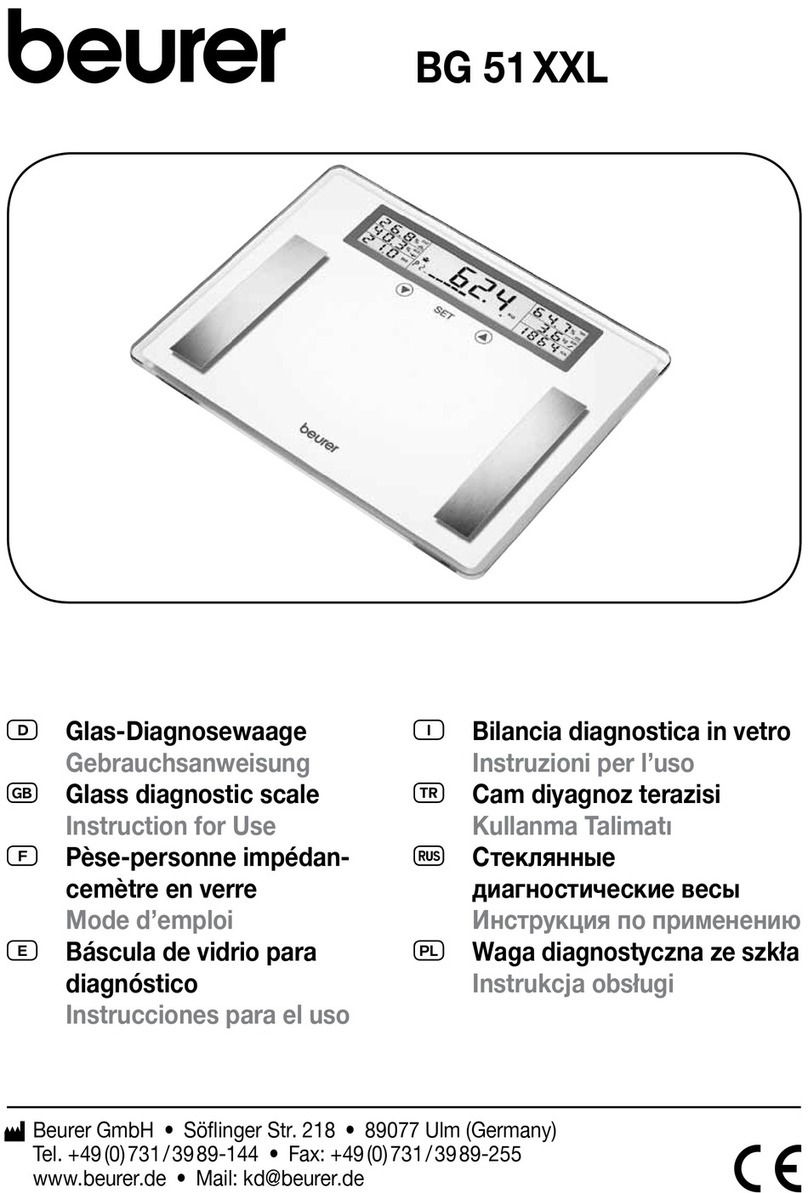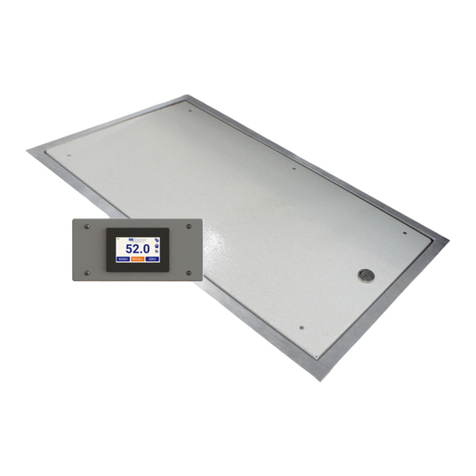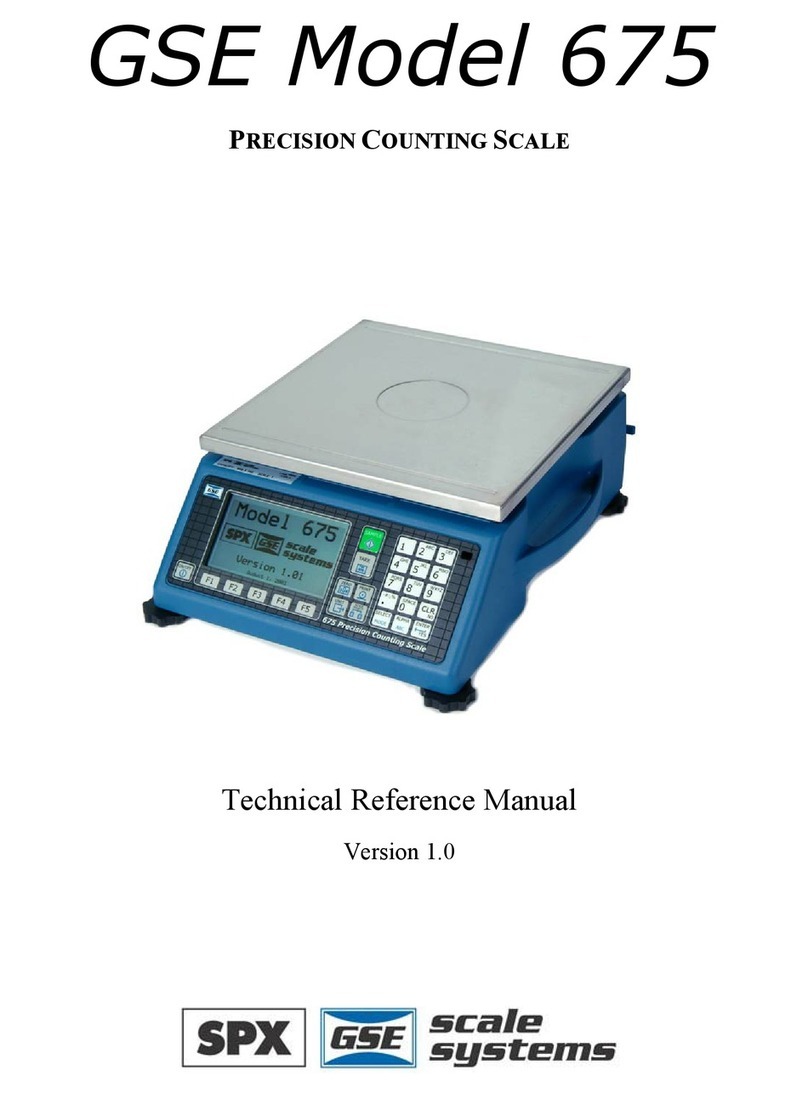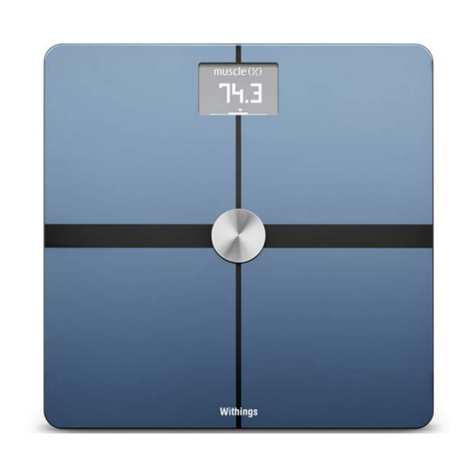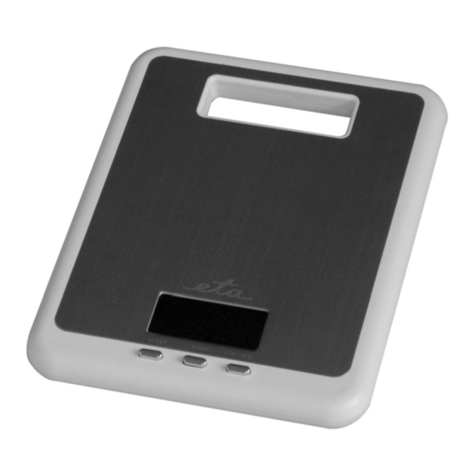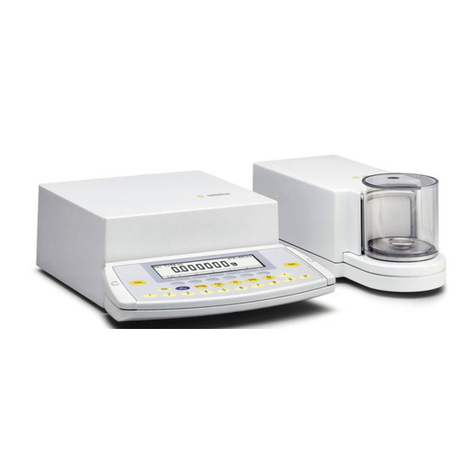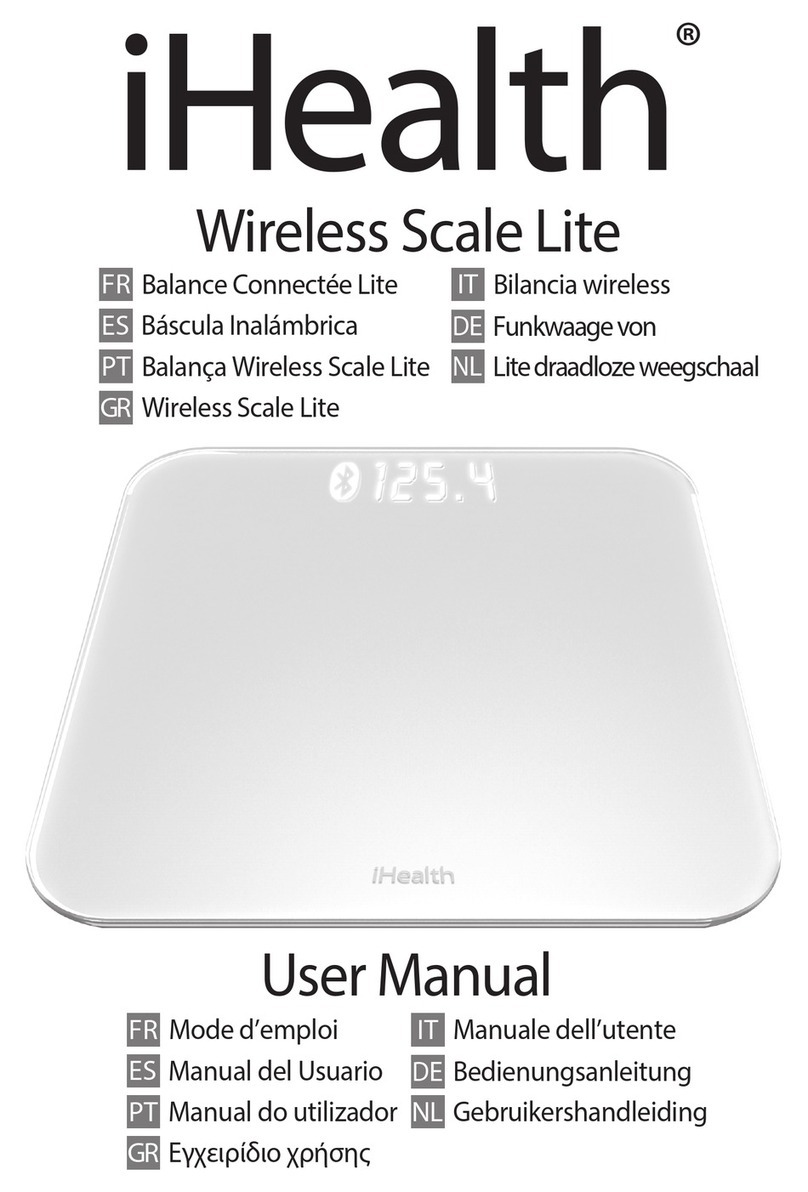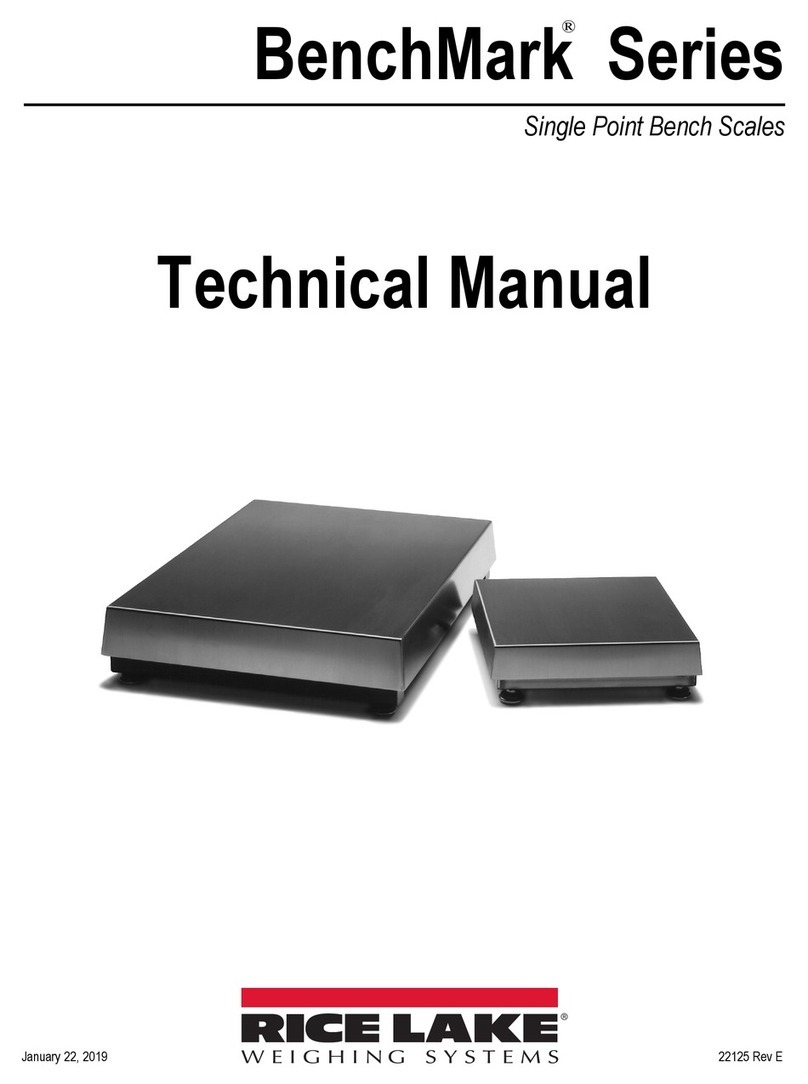Denver Instrument DA Series User manual

Denver DA Series
DA Models Operating Instructions
4ARE'ROSS .ET
&N
&UNCTION
'ROSS
.ET
4ARE
:ERO
0RINT
%NTER
%8#%,%2/.

2

Contents
Page
Safety Precautions . . . . . . . . . . . . . . . . . . . . . . . . . . . . . . . . . . . . . . . . . . . . . . . . 4
Getting Started . . . . . . . . . . . . . . . . . . . . . . . . . . . . . . . . . . . . . . . . . . . . . . . . . . . 7
General View of the Equipment. . . . . . . . . . . . . . . . . . . . . . . . . . . . . . . . . . . . . . 8
Transport Locking Device . . . . . . . . . . . . . . . . . . . . . . . . . . . . . . . . . . . . . . . . . . . 9
Setting Up the Scale. . . . . . . . . . . . . . . . . . . . . . . . . . . . . . . . . . . . . . . . . . . . . . . 10
Operating Design . . . . . . . . . . . . . . . . . . . . . . . . . . . . . . . . . . . . . . . . . . . . . . . . . 12
Power Management . . . . . . . . . . . . . . . . . . . . . . . . . . . . . . . . . . . . . . . . . . . . . . . 13
Descriptions of the Keys. . . . . . . . . . . . . . . . . . . . . . . . . . . . . . . . . . . . . . . . . . . . 14
Configuration (Setup Menu) . . . . . . . . . . . . . . . . . . . . . . . . . . . . . . . . . . . . . . . . 16
Application Programs . . . . . . . . . . . . . . . . . . . . . . . . . . . . . . . . . . . . . . . . . . . . . . 18
Counting. . . . . . . . . . . . . . . . . . . . . . . . . . . . . . . . . . . . . . . . . . . . . . . . . . . . . . . . . 18
Check Weighing. . . . . . . . . . . . . . . . . . . . . . . . . . . . . . . . . . . . . . . . . . . . . . . . . . . 19
Toggling between Weight Units. . . . . . . . . . . . . . . . . . . . . . . . . . . . . . . . . . . . . . 20
Calibration/Span Adjustment . . . . . . . . . . . . . . . . . . . . . . . . . . . . . . . . . . . . . . . 21
SBI Interface Protocol Descriptions. . . . . . . . . . . . . . . . . . . . . . . . . . . . . . . . . . . 24
Data Input Formats . . . . . . . . . . . . . . . . . . . . . . . . . . . . . . . . . . . . . . . . . . . . . . . . 25
RS-232 Interface Diagram. . . . . . . . . . . . . . . . . . . . . . . . . . . . . . . . . . . . . . . . . . . 27
Print Formats. . . . . . . . . . . . . . . . . . . . . . . . . . . . . . . . . . . . . . . . . . . . . . . . . . . . . 28
Error Codes . . . . . . . . . . . . . . . . . . . . . . . . . . . . . . . . . . . . . . . . . . . . . . . . . . . . . . 32
Care & Maintenance . . . . . . . . . . . . . . . . . . . . . . . . . . . . . . . . . . . . . . . . . . . . . . . 34
Specifications . . . . . . . . . . . . . . . . . . . . . . . . . . . . . . . . . . . . . . . . . . . . . . . . . . . . 36
Accessories (Options) . . . . . . . . . . . . . . . . . . . . . . . . . . . . . . . . . . . . . . . . . . . . . . 37
CMarking . . . . . . . . . . . . . . . . . . . . . . . . . . . . . . . . . . . . . . . . . . . . . . . . . . . . . . . 38
3

4
Measurement category
!This instrument is designed for
measurement category I, with
a maximum of 8.5V. To ensure
safe operation do not use this
instrument for measurements
within the measurement cate-
gories II, III or IV.
!Opening the instrument
CAUTION: DANGER TO LIFE!
– Working on the instrument
when it is switched on can be
dangerous to life. Disconnect
the instrument from the supply
voltage! When removing covers
of parts by means of tools,
live parts or terminals may be
exposed. Capacitors in the unit
may still be charged even after
disconnecting the unit from all
voltage sources.
– As the unit has no power switch,
to completely remove AC power
from the unit, disconnect the
AC power cable from the mains
socket.
– Do not expose the scale
unnecessarily to aggressive
chemical vapors or to extreme
temperatures, moisture,
shocks, or vibration.
– Avoid exposing the scale
to static electricity; be sure
to connect the equipotential
bonding conductor to the
junction box.
Safety Precautions
Explanation of Symbols:
!Caution, risk of danger:
Read the accompanying text
carefully.
The instrument is double-
insulated.
Protective conductor terminal
Earth ground terminal
Safety tips,
electrical protection class
!This instrument was built and
tested in accordance with the
safety regulations for measuring
and control instrumentation
for protection class I (protective
earth connection) according
to IEC 1010/ EN61010-1 or VDE
0411. The instrument was
delivered in safe condition.
To maintain this condition and to
ensure safe operation, the oper-
ator must follow the instructions
and warnings given in this
documentation
Protective earth
!The connecting cable of the unit
complies with the regulations
in accordance with VDE 0411 or
EN61010. The mains plug must
contain a protective earth
conductor, which must not be
interrupted inside or outside
this instrument (e.g. by using an
extension cable without protec-
tive earth). Before commission-
ing, acceptance of the installa-
tion by a technically competent
expert is required.

5
Repair and maintenance
– Repairs are subject to checking
and can be carried out only at
Denver. In case of defect or func-
tional trouble, please contact your
local Denver dealer for repair.
When returning the instrument for
repair, an exact and complete fault
description must be supplied.
Only a trained technician aware
of the hazards involved may carry
out maintenance work, during
which the relevant precautions
must be taken.
Important note:
– Make sure that the construction
of the instrument is not altered to
the detriment of safety.
In particular, leakage paths, air
gaps (of live parts) and insulating
layers must not be reduced. The
manufacturer cannot be held
responsible for personal injury or
damage caused by an instrument
repaired incorrectly by user or
installer.
– Only authorized service techni-
cians who have been trained by
Denver and who follow Denver’s
standard operating procedures for
maintenance and repair may open
the scale. If you see any indication
that the scale cannot be operated
safely (for example, because of
equipment damage), turn off the
scale and lock it in
a secure place so that it cannot be
used for the time being.
– If you use suction lifting equip-
ment to lift the load plate, always
wear gloves, hard-toed safety
boots and protective clothing.
Warning: This procedure can
cause personal injury! Only
reliable personnel who are quali-
fied to perform such work are
allowed to use suction lifting
equipment.
– Always make sure the scale
is disconnected from AC power
before performing any installation,
cleaning, maintenance or repair
work.
– Check the pin assignment if
you use cables purchased from
a different manufacturer. Before
connecting such a cable to Denver
equipment, check the pin assign-
ment on the corresponding wiring
diagram or chart and disconnect
any wires that are assigned
differently from those specified
by Denver. The operator shall be
solely responsible for any damage
or injuries that may occur when
using cables not supplied by
Denver.

6
!Note:
– Do not use this equipment in
hazardous areas.
– Make sure the voltage rating
printed on the power supply is
identical to your local line
voltage.
– Use only commercially
available batteries (rechargeable
or dry-cell battery). If you use
a rechargeable battery, use only
12V 2.3AH.
– The scale is energized at all
times unless you disconnect the
AC power and the battery.
– Exposure to excessive electro-
magnetic interference can cause
the readout value to change.
Once the disturbance has
ceased, the instrument can be
used again in accordance with
its intended purpose.

7
Getting Started
Storage and Shipping Conditions
Do not expose the scale to shocks,
vibrations, moisture or extreme
temperatures.
Unpacking the Scale
After unpacking the scale, check
it
immediately for any visible damage
as a result of rough handling during
shipment.
Note:
– The display and control unit is
attached to the weighing platform
via a cable.
– If you see any sign of damage,
proceed as directed in the chapter
entitled “Care and Maintenance,”
under the section on “Safety
Inspection.”
– Save the box and all parts of the
packaging until you have success-
fully installed your scale. Only
the original packaging provides the
best protection for shipment.
Before packing your scale, unplug
all connected cables to prevent
damage.
Equipment Supplied
The equipment supplied includes the
components listed below:
– Scale with attached display and
control unit
– Load pan
– Installation and operating
instructions
Installation Instructions
The Denver DA scales are designed
to provide reliable weighing results
under normal ambient conditions.
When choosing a location to set up
your scale, observe the following
so that you will be able to work with
added speed and accuracy:
– Set up the scale on a stable, even
surface
– Avoid placing the scale in close
proximity to a heater or otherwise
exposing the scale to heat or
direct sunlight
– Protect the scale from drafts
that come from open windows or
doors
– Avoid exposing the scale
to extreme vibrations during
weighing
– Protect the scale from aggressive
chemical vapors
– Do not expose the scale to extreme
moisture over long periods
– Remove transport locking:
see page 9
Conditioning the Scale
Moisture in the air can condense
on the surfaces of a cold scale when-
ever it is brought into a substantially
warmer place. If you transfer the
scale to a warmer area, make sure
to condition it for about 2 hours
at room temperature, leaving it
unplugged from AC power. After-
wards, keep the scale continuously
connected to AC power.

8
1 Manufacturer’s ID tag
2 Housing
3 Power cable
4 Display and control unit retainer
5 Display and control unit column
6 Column support foot
7 Level indicator (option)
8 Leveling feet
9 Stainless steel weighing pan
10 Power plug
11 Cable gland cover (for optional
RS-232 port outlet)
12 Load cell cable gland
General View of the Equipment
1
2
3
4
5
6
7
8
9
10
11
12

9
– Under the metal frame structure there are
four safety overload protection pins.
The transportation protection nut is painted
red (Note: not on all platform models)
Before using the scale, rotate the nut
(upwards) until tight.
Place the load plate on the scale
Transport Locking Device

10
Connecting Electronic Peripheral Devices
§Make absolutely sure to unplug the scale
from AC power or switch off (activate
battery mode) before you connect or dis-
connect a peripheral device (printer or PC)
to or from the interface port.
Warm-up Time
To deliver exact results, the scale must warm
up for at least 30 minutes after initial connec-
tion to AC power. Only after this time will the
scale have reached the required operating
temperature.
Leveling the Scale
– Remove the load plate
– Using the 4 foot screws, level the scale
so that the air bubble is centered within the
level indicator
– Check to ensure that all leveling feet rest
securely on the work surface
Setting Up the Scale

Assembly Procedure
1. Affix the column bracket with 4 screws
2. Install the column support leveling foot
3. Insert the column into the bracket holder
4. Affix the column with 2 screws
5. Insert the display and control unit retainer
into the column
6. Tighten the screw on the display and control
unit bracket
7. Secure any excess cable to the foot of the
stand using a cable clip.
Battery-Powered Operation
To activate battery operation:
– Open the battery cover at the back of the
Indicator.
– Insert 1.5 V size D dry-cell batteries
(not included) into the battery compartment.
– The battery symbol is displayed when the
unit is operating on battery power.
– If the battery symbol flashes, the battery
power is weak.
Replace the batteries (if using dry-cell
batteries).
3
4
6
5
1
2
7
11

12
Busy Symbol, Plus/Minus Sign
If the symbol displayed here is
a diamond b, this indicates that the
scale is performing a function (busy
symbol). A plus or minus sign (+ or –)
refers to the value displayed.
Measured Value
Shows the measured value
Basic Unit and Additional
Information
– When the scale has stabilized,
the weight unit is displayed here
(g, kg,..).
– The arrows below the weight
indications shows the weighing
mode (gross/net) and the appli-
cation mode (counting, check-
weighing, or unit toggling)
enabled, if any.
– The !symbol indicates the
unit is not in weighing mode (e.g.:
calibration mode, configuration
mode, error mode)
Operating Design
The scales in the DA series consist of
a weighing cell and a display and
control unit. In addition to the choice
of power supply or rechargeable
maintenance-free lead acid battery
or dry battery, your scale also has
an interface port for connecting
peripheral devices, such as a printer,
computer, etc.
The display and control unit is
affixed to the weighing platform.
Operation of the DA scale is simple
and uniform. The DA models include
the features like gross/net toggling,
counting, checkweighing & unit
toggling.
Display
The display is divided into sections:

13
Power Management
Scale connected to AC power:
On/Off Switch:
On: Scale is operational and
display shows function or mode that
is in use
Off: Depends on menu setting
(“4. Standby option.”), scale is com-
pletely off (no display and no internal
circuitry) or in standby (no display
and internal circuitry working).
Back Light:
Depends on menu setting
(“2. Backlight”). Backlight is on/off.
Auto Power Off:
Not active.
Scale running on battery power:
On/Off Switch:
On: Scale is operational and the
display shows the function or mode
that is in use
Off: Completely off (no display and
no internal circuitry working)
Back Light:
Depends on menu setting (“2. Back-
light”). Backlight is on/off. Backlight
goes off after 15 seconds if no
operation is done (no key pressed/
no weighing). Backlight comes back
on whenever a key (except on/off)
is pressed or when a load is placed
on the scale.
Auto Power Off:
Depends on menu setting
(“3. Auto power off”); system power
shuts down. Time limit options for
auto power in setup menu are 5, 10
or 15 minutes, or can be disabled.

Descriptions of the Keys
1 6
2345
14
1) On/Off
“On/off” function will depend on
different power supply conditions.
Use the setup menu for backlight
control and for auto power off.
In Main Mode
§Off-Mode:
If standby active: Scale is in
standby mode, but there is no
display visible other than mode
symbol (no backlight, no display,
no symbols)
If standby not active:
Scale is completely off
§On-Mode:
Scale is in operation and the
display shows the function that
is in use.
In this mode, auto power off
function is invalid.
In Battery Mode
§Off-Mode: Scale is completely off.
§On-Mode: Scale is in operation
and the display shows the function
that is in use. Backlight works
based on setup menu
In this mode, auto power off
function is valid. After 5, 10 or
15 minutes, the system shuts off
when not in use in accordance
with the setup menu setting.
2) Zero/Arrow-Left (Zero/Left)
Weighing mode: Set scale to zero
Parameter mode:
Shift position of digit to the left
3) Tare/Arrow-Right (Tare/Right)
Weighing mode: Tare the scale
Parameter mode:
Shift position of digit to the right

15
4) Gross-Net/Arrow-Down
(Gross/Net/Down)
Weighing mode:
Toggle weight unit gross/net
Counting mode:
Toggle weight unit gross,
net and pcs
Function mode:
To scroll down menu selection
Parameter mode:
Reduce digit value by 1
5) Function/Arrow-Up (Fn/Up)
Weighing mode:
Switch the scale from normal
weighing mode to application
setup mode
Function mode:
Scroll up in menu selection
Parameter mode:
Increase digit value by 1
6) Print/Enter (Print/Enter)
Weighing mode: Print key
Function mode:
Scroll level up in menu mode/
confirm selected menu.

16
To configure the user interface of the scale to individual requirements
Step Key (or instruction) Display
1. Switch off the scale |/E
2. Switch on the scale |/E
3. While all the segments
are displayed: Press
(zero/left arrow) and
hold until “1.” appears in the display.
Navigation in the Setup Menu
Key Function
(Print/Enter) Menu item: Confirm setting
(Fn/Up) Menu item: Scroll up
Digit input: Increase by 1
(Gross/Net/Down) Menu item: Scroll down
Digit input: Reduce by 1
(Zero/Left) Digit input: Selection shift left
(Tare/Right) Digit input: Selection shift right
Exit setup menu: Hold down (zero/left arrow) for more than
2 seconds
Configuration (Setup Menu)

17
Setup Menu 1. Serial COM 1.1 Baud rate 1.1.1 600
1.1.2 1,200
1.1.3 2,400
1.1.4 4,800
1.1.5 9,600*
1.1.6 19,200
1.2 Parity 1.2.1 7-bit-None
1.2.2 7-bit-None
1.2.3 7-bit-None
1.2.4 8-bit-None
1.2.5 8-bit-None
1.2.6 8-bit-None
1.3 Print option 1.3.1 Short*
1.3.2 Long/block
1.3.3 Continuous
2. Backlight 2.1 On*
2.2 Off
3. Auto Power Off 3.1 No options*
3.2 5 Min.
3.3 10 Min.
3.4 15 Min.
4. Standby Options 4.1 On*
4.2 Off
5. Adapter Filter 5.1 Very stable conditions
5.2 Stable conditions*
5.3 Unstable conditions
5.4 Very unstable conditions
6. ADC Configuration 6.1 Decimal point 6.1.1 0
6.1.2 1
6.1.3 2
6.1.4 3
6.1.5 4
6.2 Basic unit 6.2.1 g
6.2.2 kg
6.2.3 lb* For some countries,
6.2.4 oz these units
6.2.5 t are disabled
6.3 Step width 6.3.1 1
6.3.2 2
6.3.3 5
6.4 e<>d frame 6.4.1 On
6.4.2 Off*
6.5 Adjust FSD (span) 6.5.1 (Enter FSD weight)
6.6 Calibration weight 6.6.1 (Enter CAL weight)
6.7 Linearisation weight 6.7.1 (Enter Lin weight)
7. Reset Menu 7.1 Do not restore
7.2 Restore
* = Factory setting

18
Counting
Step Key (or instruction) Display
1. Select application program (Fn/Up) > 2 sec
2. Select “Counting” (Fn/Up) or
(Gross/Net/Down)
repeatedly
3. Press Print/Enter. (Print/Enter)
Display shows reference piece
selection menu.
Counting is blinking.
4. Automatically the display
will show the reference pieces. (Tare/Right)
Place container and press
Tare if required (display “tared”).
5. Select reference sample quantity: (Fn/Up) or
5, 10, 20, 50 or 100, and put the (Gross/Net/Down)
reference on the scale. repeatedly
(quantity flashes)
6. Press Print/Enter.
Now “O” flashes. Automatic (Print/Enter)
optimization is active.
To update reference sample:
7. Place more reference samples
on scale (The number is
x+2 ~ 2x times the reference
pieces (x) selected in step e.)
8. Place uncounted parts/samples
on the scale
9. Toggle between reference (Gross/Net/Down)
(Gross/Net/Down) piece weight,
total weight, and total pieces.
10. Unload the scale
11. Counting application: Clear (Zero/Left) > 2 sec
OK
Application Programs
18

19
Check Weighing
Step Key (or instruction) Display
1. Select application program (Fn/Up) > 2 sec
2. Select “Checkweighing” (Fn/Up) or
(Gross/Net/Down)
repeatedly
3. Press Print/Enter to confirm. (Print/Enter)
4. Set lower limit; “LO” flashes. (Fn/Up) or
(Gross/Net/Down)
and/or (Zero/Left)
or (Tare/Right)
5. Press Print/Enter to (Print/Enter)
confirm and save.
6. Set upper limit, (Fn/Up) or
“HI” flashes, and then press (Gross/Net/Down)
Print/Enter. and/or (Zero/Left)
or (Tare/Right)
7. Press Print/Enter to confirm (Print/Enter)
and save.
8. Place the sample on the scale.
Display shows the difference
and HI/LO symbol
9. Unload the scale
10. Checkweighing application: (Zero/Left) > 2 sec
Clear

20
Toggling between Weight Units
Step Key (or instruction) Display
1. Select application program (Fn/Up) > 2 sec
2. Select “Toggling Weight Units” (Fn/Up) or
(Gross/Net/Down)
repeatedly
3. Select weight unit 1 (Fn/Up) or
(Gross/Net/Down)
4. Confirm weight unit 1 (Print/Enter)
5. Select weight unit 2 (Fn/Up) or
(Print/Enter)
6. Confirm weight unit2 (Print/Enter)
7. Place sample on the scale
8. Toggle weight unit (Fn/Up)
9. Unit toggling application: (Zero/Left) > 2 sec
Clear
(unit changes to basic unit set)
Table of contents
Other Denver Instrument Scale manuals

Denver Instrument
Denver Instrument TP Series User manual
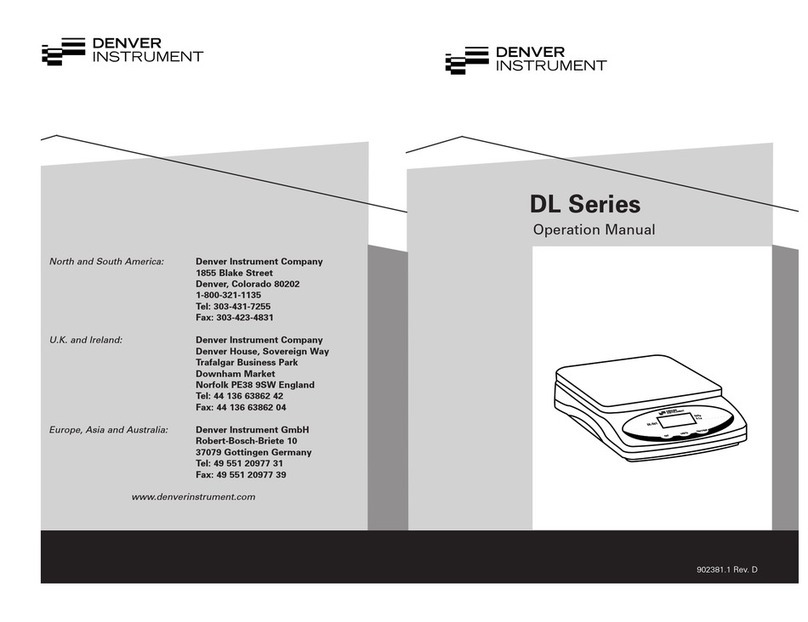
Denver Instrument
Denver Instrument DL series User manual
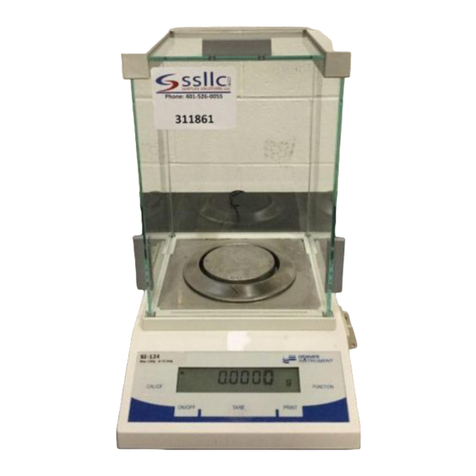
Denver Instrument
Denver Instrument TB Series User manual
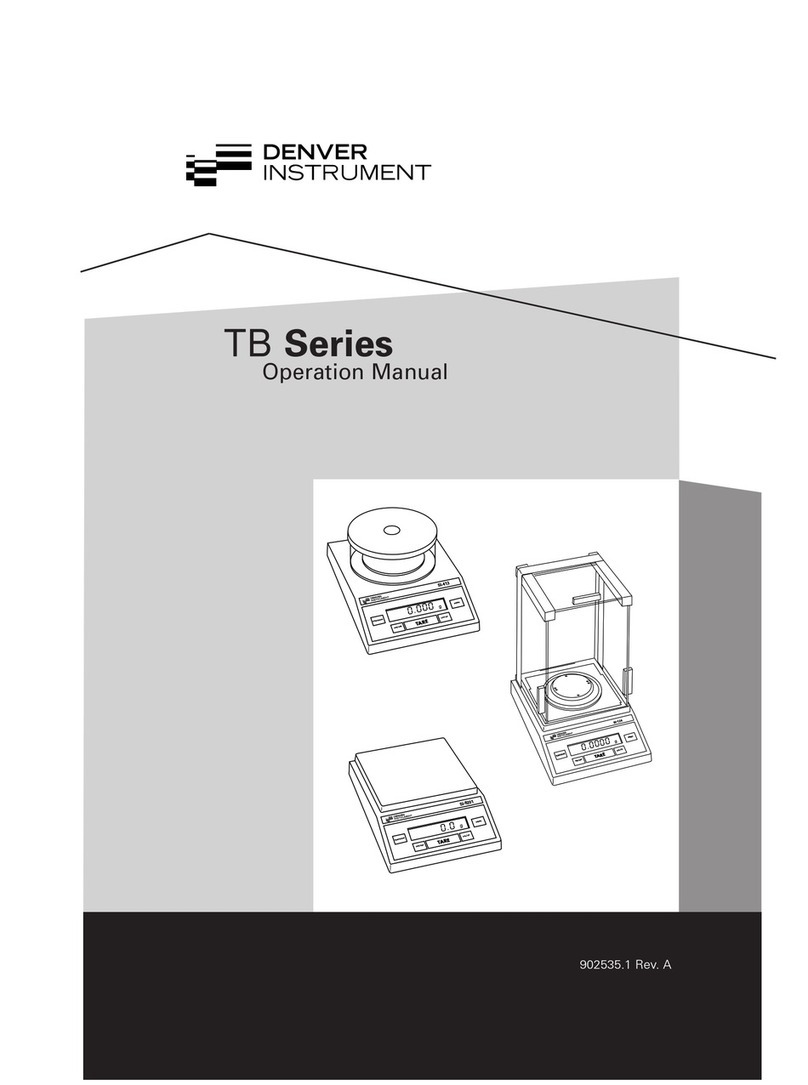
Denver Instrument
Denver Instrument TB-124 User manual
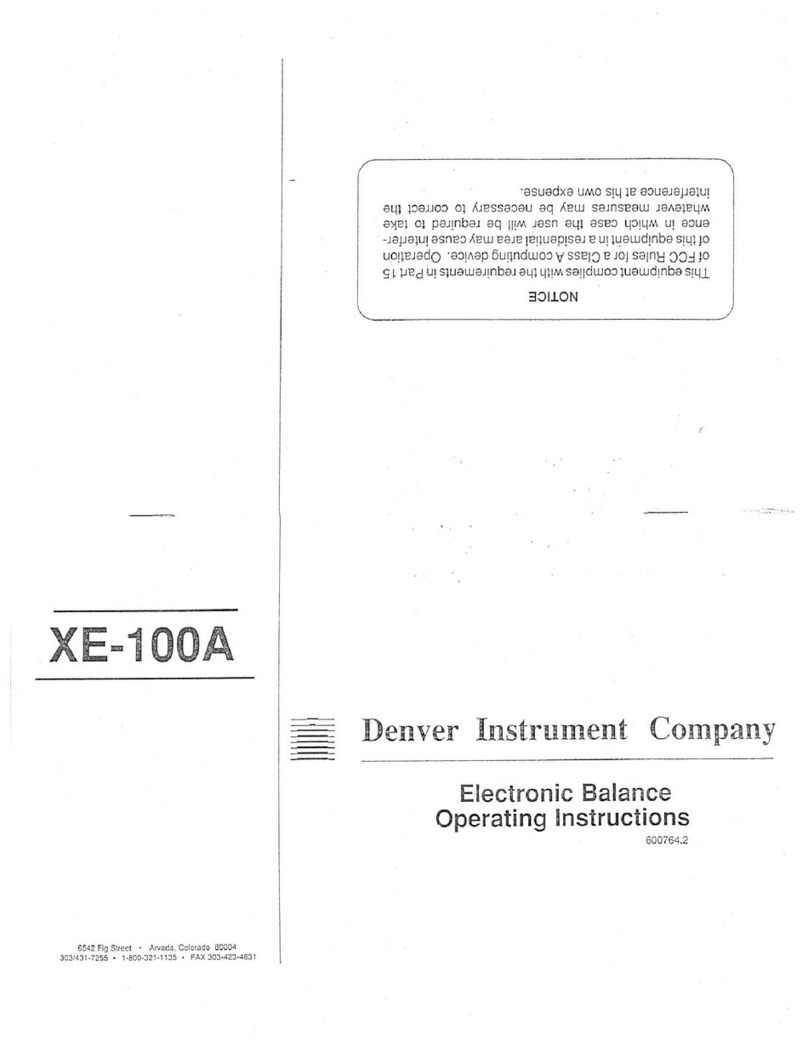
Denver Instrument
Denver Instrument XE-100A User manual
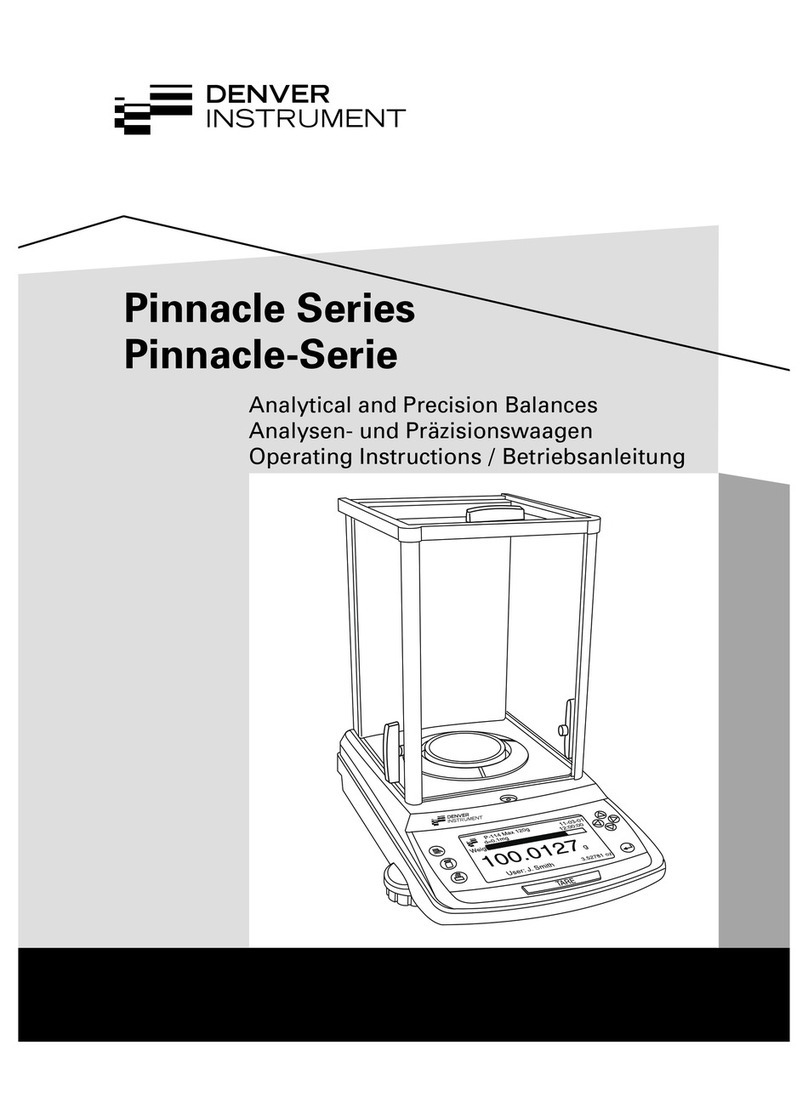
Denver Instrument
Denver Instrument P-114 User manual
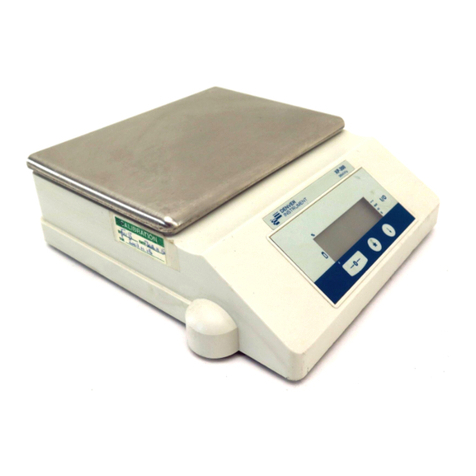
Denver Instrument
Denver Instrument XP Series User manual
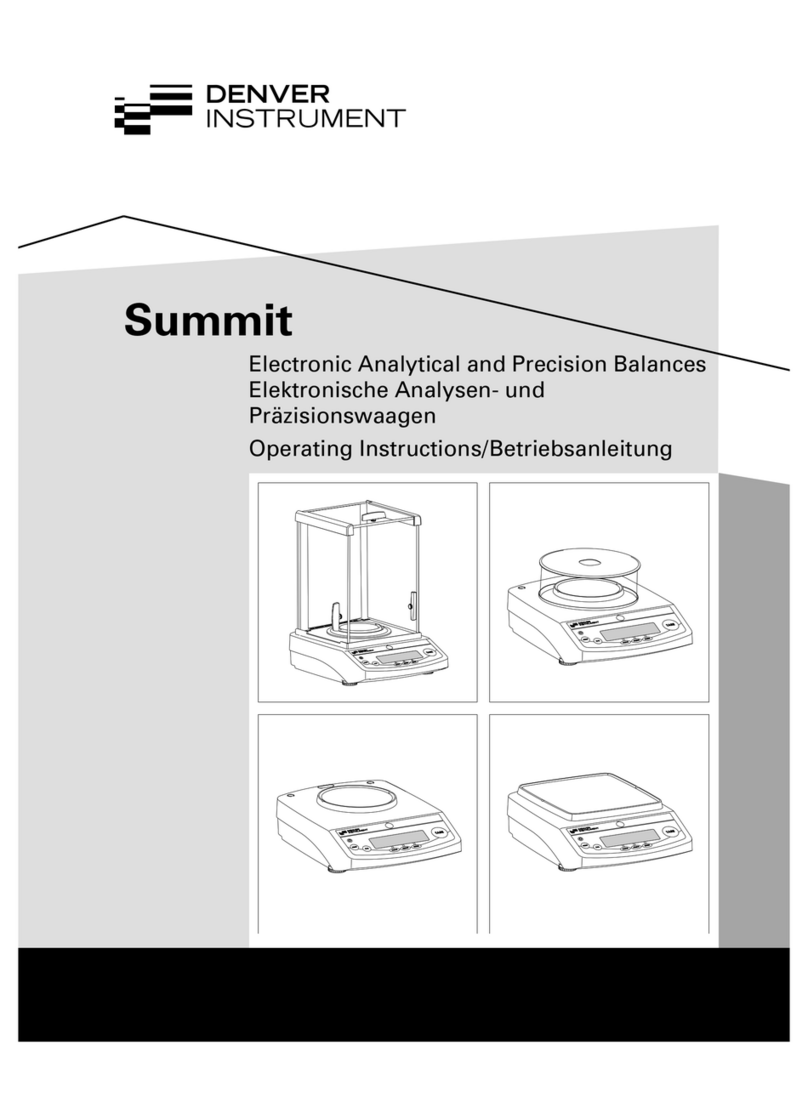
Denver Instrument
Denver Instrument Summit User manual

Denver Instrument
Denver Instrument ACA-100 User manual

Denver Instrument
Denver Instrument MAXX User manual



